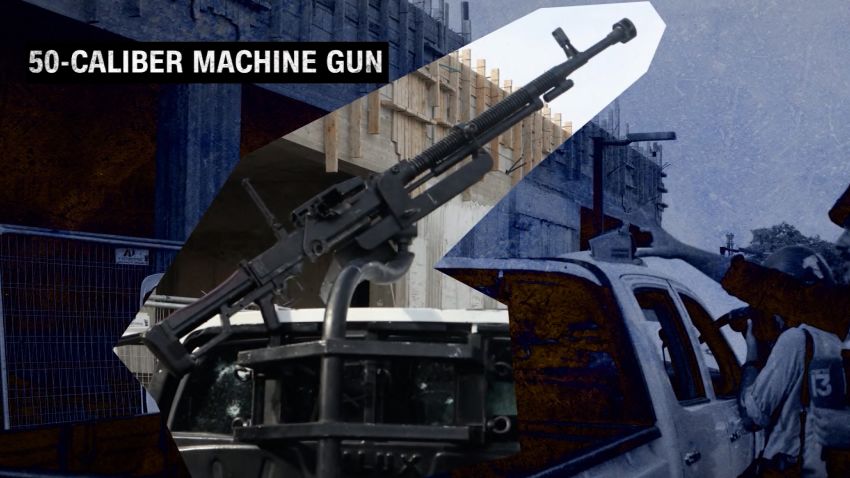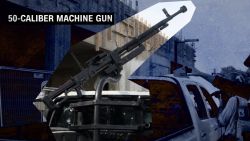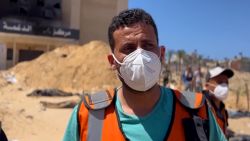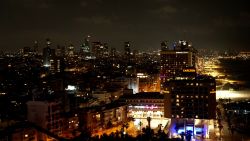Homemade rockets. Modified AK-47s. Decades-old Soviet machine guns. Cheap, second-hand, and purloined weapons comprised Hamas’ deadly makeshift arsenal that fueled a devastating, multi-pronged attack on Israel over the weekend.
CNN analyzed dozens of photos and videos of Hamas militants during the surprise assault to identify the weapons used to kill at least 1,200 people in Israel. Many of the weapons appeared to be altered Russian or Chinese firearms, presumedly left behind on the battlefield in decades past that eventually made their way into the hands of Hamas terrorists, experts say.
One expert described how the intricately planned assault, in which Hamas terrorists infiltrated Israel by land, sea and air, reflects a change in Hamas’ overall military strategy. Others believe certain firearms were likely supplied from Iran, which the US State Department has said bolsters the terrorist group with money, military equipment and training.
The group operates out of Gaza, a strip of Mediterranean coastal land bordered by Israel and Egypt, which has been cut off from the rest of the world since 2007 when Hamas seized control of the territory, prompting Israel and Egypt to impose a blockade on it.
It’s fertile ground for a condemned terror group to scavenge and transform weapons for guerrilla warfare.
While the weapons are far less sophisticated than Israel’s standards – that country’s military has access to some of the best equipment the US can provide – their impact made for an unprecedented level of devastation.
“Those are weapons of mass destruction in my eyes,” said Ret. US Army Major Mike Lyons, referring to portable surface-to-air missiles that can be seen in at least one video reviewed by CNN.
But Hamas’ fighters don’t need sophisticated equipment to be deadly, Lyons said. “They just need to create terror.”
Machine guns
Images analyzed by CNN show a Soviet-built DShK, a .50 caliber machine gun, modified and rigged to a pickup.
The gun usually requires two people – one to feed the gun with bullets and another to fire, Lyons said. But he suspects that this weapon was tweaked, making it easier to operate by a single fighter.
“Some guy could sit down, put his hand by the trigger and shoot with one hand and do something with the other hand,” Lyons said. “These things wreak havoc.”
The weapons, which are designed to penetrate military vehicles and aircraft, are frequently used by professional militaries. They are typically mounted to a tripod or armored vehicle and used as a defensive weapon in combat.
“It is uncommon … to see (this weapon) being sent into an unguarded, no-military-presence village,” said John Spencer, the chair of Urban Warfare Studies at the Modern War Institute at West Point. “It’s like a militarized killing or active shooter.”
AK-47s
In many of the videos and photos CNN analyzed, assailants toted AK-47s. Lethal, user friendly and easy to find, it’s the preferred assault rifle for militant groups, experts said.
“If you hold down the trigger, you can empty the whole magazine. It has a high cyclic rate of fire. It can be used to spray bullets,” said Stephen Biddle, a Columbia University professor and defense expert, who described the ubiquity of the weapons. “It’s not like Hamas went out of its way to acquire these things.”
One video published on Hamas’ Telegram channel shows fighters – most carrying AK-47s – storming an Israeli military outpost. The assailants make their way through Israeli neighborhoods, fire at an Israeli tank and hold civilians at gunpoint.
Several of the experts CNN spoke to mentioned modifications that some groups will make to AK-47s, including removing equipment to make the weapons lighter and easier to use.
“They would modify it because they’re just all about practicality,” said Lyons.
Spencer noted that modifications like these are often a sign of an unprofessional, yet still dangerous force.
“If it was all standardized, that would be a sign of professionalization,” he said. “You can make minor modifications to older equipment to make it just as effective or make it a little more effective or ergonomic.”
Some of the AK-47s, according to several experts, are also likely old Soviet weapons that were left behind during the federation’s invasion of Afghanistan in the 1980s. Others may be old Chinese weapons funneled into the terrorists’ weapons network. Some may have come from Iraq, where Saddam Hussein bought AK-47s by the thousands. Also, a slew of small arms from Libya penetrated the black market in the 2010s, experts say.
To Lyons, this is the conundrum when more sophisticated militaries leave equipment behind on the battlefield – it may eventually wind up in the hands of terrorist groups.
“This could have been filmed 40 years ago. This is the same equipment,” Lyons said. “They’re simply designed, and they’re designed to work in the most austere and worst conditions in the world.”
Rockets
Hamas has long depended on rockets to fight its asymmetrical battles with Israel. On Saturday alone, the militant group claimed it fired 5,000 rockets on Israel, most of which were intercepted by Israel’s Iron Dome air defense system.
Still, the sheer number of rockets has at times overwhelmed the Iron Dome, a state-of-the art system equipped with a radar to detect incoming projectiles and shoot them down.
Some even landed unexploded in Israeli homes. In a short video posted on Telegram, a man shows the remains of a Hamas rocket protruding through a bedroom ceiling. The rocket appears to be an unexploded Qassam or Saraya al-Quds rocket, said a British researcher who runs Calibre Obscura, a website that identifies weapons. Both rockets are identified, the researcher noted, by the groups that use them: Hamas’ military wing, known as the Izz al-Din al-Qassam brigades; and the al-Quds brigade of the Palestinian Islamic Jihad, a rival Islamist group in the Gaza Strip.
Hamas produces the vast majority of its own Qassam rockets these days, said the researcher, given the difficulties of smuggling in larger rockets into the blockaded Gaza Strip. How the group manufactures the makeshift rockets is less known. In previous battles with Israel, Hamas was known to have fired rockets made of old water pipes, the researcher noted.
A senior Hamas official based in Lebanon gave details of the group’s weapons manufacturing in an edited interview with Russia Today’s Arabic-news channel RT Arabic published on their website on Sunday.
“We have local factories for everything, for rockets with ranges of 250 km, for 160 km, 80km, and 10 km. We have factories for mortars and their shells. … We have factories for Kalashnikovs (rifles) and their bullets. We’re manufacturing the bullets with permission from the Russians. We’re building it in Gaza,” Ali Baraka, head of Hamas National Relations Abroad, told the outlet.
But former US officials say there is little question the massive stockpile of weapons used in Saturday’s attack was acquired and assembled with help from Iran.
“Hamas didn’t build the guidance system and those missiles in Gaza,” said retired Gen. Frank McKenzie, the former commander of US Central Command. “They got them from somewhere. And the technology assistance to put it together certainly came from Iran – where else would it have come from?”
Grenades
In the early stages of their attacks, Hamas militants employed grenades as they stormed Israeli towns and villages near the Gaza Strip.
In one dashcam video verified by CNN, a militant tosses a grenade into a bomb shelter near the site of the Nova music festival. The fighters then immediately take cover as a man flees the shelter.
“They all sought shelter, which is what people who’ve done that before would normally do,” said former Lt. David Benson, who served in Iraq and now works at a security firm. The video indicated a level of training among the fighters, he said.
Hand grenades appear again in an October 8 Reuters photo. The image shows Israeli troops inspecting weapons laid out on a sidewalk outside a police station in the border town of Sderot. Three experts told CNN that the devices appear to be hand grenades.
Whether Hamas obtained the grenades or manufactured them remains unclear, but the fact that they had them at all suggests the group has built up its capabilities in recent years.
“Hand grenades are expensive, even in the American military,” Benson said.
Drones
A video posted on a Hamas social media account show a bird’s eye view of munitions that Hamas claims to have dropped on Israeli soldiers by drone. CNN has been unable to verify the authenticity of the video, but a similar weapon was used in the initial attack, during which Hamas dropped bombs on unmanned machine gun towers at an Israeli outpost along the border.
Biddle said it appears the drones in that video are targeting sensors that monitor the fence separating Gaza from Israel, indicating a planned attack. “The first thing to do is not break through the fence, it’s to destroy the sensors.”
Spencer told CNN this points to not only state-backed supplying, but also training to know how to use the devices and which bombs would be the most effective for their targets.
“The drones are the only thing that surprised me. It is normal to think they’d have them, but to have that level of coordination and sophistication of the attack, and to include the videos they released … That to me, again, strongly points to a state-backed sponsor of Hamas militants,” said Spencer.
In another video released by Hamas and geolocated by CNN, a drone appears to place a timed IED over an automatic remote-controlled machine gun in an Israeli outpost near Kfar Aza, Israel.
Paragliders
In another Hamas video analyzed by CNN, militants can be seen strapped to a sail and entering Israel during the initial wave of Saturday’s attack as rockets launched near Beit Lahia, Gaza, rain down.
Paragliders, which use wind to propel forward and upward, or powered parachutes, which have an engine, are commonly used by adventure seekers. But they aren’t commonly used in warfare – and for good reason.
“Paragliders are incredibly vulnerable and not particularly maneuverable,” Benson said.
Sean Elliott, vice president of Industry & Regulatory Affairs at the Experimental Aircraft Association, agreed.
“They’re fairly narrow in scope,” Elliott said. “You need (the) right conditions and the right environment. There’s a lot of weaknesses.”
But it has happened before. In late 1987, a Palestinian fighter strapped to a hang glider – similar to a paraglider but it has a rigid frame for its wings – entered Israeli airspace. The fighter, armed with hand grenades, a pistol and an assault rifle, killed six Israeli soldiers and wounded seven others before he was killed, TIME reported.
And more recently, in 2012, a suspected al Qaeda terrorist cell in Spain was found with three motorized paragliders and was trained by a local instructor on how to fly them.
But Spencer said Hamas didn’t just pull the paragliders from shelves at an outdoor store and suspected that the group may have been trained and supplied by a sponsor outside Gaza.
“They didn’t come up with the equipment themselves,” Spencer said.
Bulldozers
Several experts who spoke to CNN emphasized the ad hoc nature of the Hamas attack. Fighters appear to use whatever was at the militant group’s disposal to execute the strike.
Images from the initial attack show a bulldozer being used to tear down a fence that separates Gaza from Israel.
In some videos, Hamas militants can be seen driving Israel Defense Forces (IDF) vehicles and using Israeli weapons that were likely taken during the initial fighting.
Hamas has also reportedly worn Israeli soldier’s uniforms to confuse Israeli forces—a tactic they’ve used during previous warfare.
“The practice of Hamas dressing as IDF soldiers to capture other areas, soldiers or to get close enough to attack is a very common tactic of theirs,” said Spencer.
CNN’s Gianluca Mezzofiore, Paul Murphy and Pete Muntean contributed to this report.






















